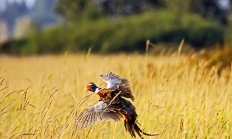Search myodfw.com
The skies near favored stopover locations are filled twice annually with the sights and sounds of these geese as they migrate between Arctic breeding grounds and wintering areas farther south. Snow geese share very similar all-white plumage and black wing tips with the less common Ross's goose. These are Oregon's only wild white geese. It is predominantly a spring and fall migrant, especially abundant in large wetland and agricultural complexes such as Malheur National Wildlife Refuge, Silvies River floodplain in Harney County, Lower Klamath National Wildlife Refuge and Klamath Wildlife Area. Wintering snow geese in Oregon are found primarily along

The American beaver, the largest rodent in North America, commonly weighs in excess of 55 pounds. The beaver is highly modified for aquatic life with a compact body, paddle shaped tail, webbed hind feet, valves that close their ears and nose while diving, and a rich oil gland that waterproofs their fur. Under water, membranes cover the eyes. Claws on the first and second toes are split and function in grooming; the ears and eyes are small; the tail is broad, scaly and nearly without hairs. The thick underfur is overlain with coarse guard hairs; overall, the pelage (coat) is
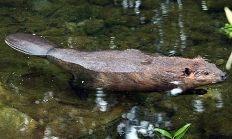


Find maps, boundary information and the percent public land in the Powers Unit.
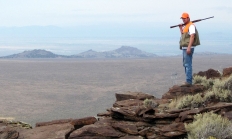
Features: Cabezon are a dark green to dark brown with mottling along their sides and with smooth, scaleless skin. The largest cabezon caught was over 20 pounds, but on average they weigh approximately 4 pounds. Habitat: Cabezon live around kelp beds and rocky headlands over hard bottoms. Technique: Cabezon are best caught using rubber tailed jigs tipped with bait. Make sure you are fishing within just a foot or two of the bottom as Cabezon like to hold tight to cover. CAUTION: While Cabezon meat can be safely consumed, its roe is poisonous to humans. Photo credit: Brandon Ford


Features: Circular in shape and 1.5-2.5 inches across. Identified by concentric lines and radiating ridges. Longer lived and less abundant than cockles. Habitat: High salinity areas of sand, mud, gravel, or rock. Harvest them in Tillamook, Netarts, Yaquina, and Coos bays. Techniques: These clams can be found in rocky nearshore areas within 6 inches of the surface. Using a rake for these clams is the best harvest method. Learn more here before getting started clamming. See Oregon Sport Fishing Regulations for information on the daily catch limits for bay clams. How to dig for little neck clams (video)
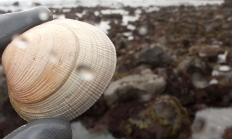
Features: These fish are dark green, gray or brown on top with an off-white belly and silver or tan sides. The underside of the head and fins can be pinkish. Long second anal fin spine. Silvergrays can be confused with bocaccio rockfish which have a short second anal fin spine. Habitat: Most commonly found between 330 and 990 feet though subadults have been found in kelp beds only 56 feet deep. Adults live over various rocky-bottom habitats. Technique: Work rubber tail jigs or shrimp flies through the schools containing these fish.
Upper and Lower Bennett Dams are located southeast of the town of Stayton on the North Santiam River. Upper Bennett Dam is on the south side of Stayton Island and Lower Bennett Dam is on the north side.
Of several swans found in Oregon, the tundra swan is by far the most common during the non-breeding season. It is most readily distinguished from the similar-appearing trumpeter swan by voice, although subtle differences in physical appearance and behavior can separate the two with difficulty. It is a fairly common transient throughout the state but most abundant at large bodies of water and wetland complexes east of the Cascades including the Malheur National Wildlife Refuge and the surrounding Harney Basin, Summer Lake Wildlife Area and the Klamath Basin. Hear the call of the tundra swan Photo by Kathy Munsel, ODFW

Features: Brant are a small to medium-size goose. They have smoky black backs and bellies, and dissected white collars and white around the tails provide striking contrast. The brant can live up to 20 years and are resilient enough to ride out storms on the open ocean. Habitats: Brant are primarily found in bays and estuaries, but on occasion can be found inland. They forage on eel grass and other aquatic vegetation. Most of their feeding is in shallow water or in tidal flats. They tend to feed in flocks. Techniques: As with any waterfowl hunting, location is key. Seek

Features: Eulachon smelt ( Thaleichthys pacificus) grow to be 6-9 inches long and live 3-5 years. They have elongated bodies with relatively large mouths. They are blueish on top and silvery on their sides and bellies. Habitat: The Pacific smelt spends most of its life in the ocean, migrating up rivers, including the Columbia and its tributaries, to spawn. The eggs attach to gravelly, woody, or sandy substrate of the river bottoms, but upon hatching the juvenile smelt get swept downstream back to the ocean. Technique: Dip netting for smelt when they run in the Sandy River is a great

Features: This species is relatively thin compared to other rockfish. It is easily recognized by its three to four horizontal green stripes that extend onto the caudal fin membranes. The body color ranges from white to reddish; red or orange areas can be observed on the body after capture. Habitat: Though found between 40 and 1,632 foot depths, these rockfish tend to stay between 300 and 825 feet with older/larger individuals found deeper. They live on muddy, sandy and rocky bottoms. Technique: Rubber tail jigs or shrimp flies are good choices when targeting greenstriped rockfish. Be wary of sharp dorsal
Features: Lingcod have an elongated body with a large mouth and sharp, canine-like teeth. They are generally mottled gray or brown but sometimes green or blue. A green-colored “ling” should not be confused with a greenling. Lingcod can get 5-feet long, but those caught in Oregon average between 2- and 3-feet. Habitat: Adults like to be near rocks, inshore and to 230-fathoms deep. Young lingcod prefer the sand or mud bottoms of bays and inshore areas. Technique: Bounce some bait along the bottom with 5/0 or 6/0 hooks, a 4- to 6-ounce sinker, and 20-pound line on a stout rod
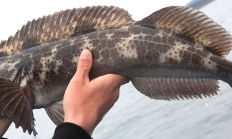
Some of Oregon's larger mammals, such as deer and elk can easily be seen at places like Jewell Meadows Wildlife Area, Dean Creek Elk Viewing Area, and the North Bank Habitat Management Area. Black-tailed deer are frequently seen in western Oregon along roadsides. Commonly seen animals include raccoons, rabbits, squirrels, and skunks. A quiet walk in the forest or desert, a keen eye and a good pair of binoculars will reward you with glimpses of some of our more secretive animals. Some viewing tips include: keep your distance, move as silently as possible or pick a spot and remain still
Features: Rocky Mountain elk are one of two subspecies of elk found in Oregon, with a population estimate of more than 74,000 in the state. They are lighter in color and slightly smaller in size than Roosevelt elk, but their antlers are the largest of all elk and can weigh up to 40 pounds. Habitat: Rocky Mountain elk inhabit most of eastern Oregon with concentrations in the Blue Mountains and south-central Oregon. Techniques: Rocky Mountain elk live in much more open country that Roosevelts so try glassing, still hunting, spot and stalk and calling. Rifle, archery and muzzleloader seasons are

SE Fishing December 4, 2025 Best bets for weekend fishing Yellow perch fishing is still an option in Recreation Creek, Pelican Bay Area of Upper Klamath Lake, Sevenmile Canal Mouth, and Fourmile Canal. Best fishing for wild, native trout in the Klamath Basin will be the Klamath River. There are some nice holdover trout in the Malheur River below Warmsprings right now. Trout fishing has been great at Chickahominy Reservoir Crappie are abundant in Wolf Creek Reservoir with some nicer fish around 8 inches available. Crappie fishing in Owhyee Reservoir has been good. Channel catfish are a popular option. Find
